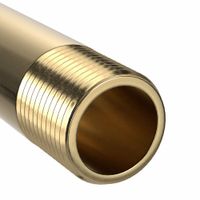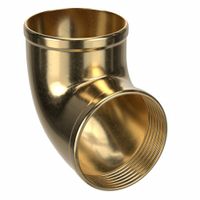Call +(254) 703 030 000 / 751 483 999 / 721 704 777
- Home
- Pipe Hose Tube Fittings
- Pipe Pipe Fittings
- Standard Pipe Pipe Fittings
- Brass Bronze Pipe Systems
.....Read More
Frequently Asked Questions
1. What are the main differences between brass and bronze pipe fittings?
Brass and bronze pipe fittings differ primarily in composition, properties, and applications.
**Composition:**
- **Brass** is an alloy of copper and zinc. The proportion of zinc can vary, which affects the properties of the brass.
- **Bronze** is primarily an alloy of copper and tin, though it may contain other elements like aluminum, manganese, or nickel.
**Properties:**
- **Brass** is known for its malleability, making it easier to shape and form. It has a bright, gold-like appearance and is resistant to corrosion, though it can tarnish over time.
- **Bronze** is generally harder and more brittle than brass. It has a duller, reddish-brown appearance and is more resistant to corrosion, especially from saltwater, making it ideal for marine applications.
**Applications:**
- **Brass fittings** are commonly used in plumbing, electrical applications, and decorative items due to their ease of machining and attractive appearance. They are suitable for low to moderate pressure systems.
- **Bronze fittings** are often used in applications requiring higher strength and corrosion resistance, such as in marine environments, bearings, and bushings. They are preferred in high-pressure systems and where durability is crucial.
**Cost:**
- **Brass** is generally less expensive than bronze due to the cost of zinc compared to tin and other alloying elements in bronze.
**Machinability:**
- **Brass** is easier to machine than bronze, which can be more challenging due to its hardness.
In summary, the choice between brass and bronze pipe fittings depends on the specific requirements of the application, including factors like corrosion resistance, strength, appearance, and cost.
2. Can brass and bronze pipes be used for transporting drinking water?
Brass and bronze pipes can be used for transporting drinking water, but there are important considerations to keep in mind.
Brass is an alloy primarily composed of copper and zinc, while bronze is primarily copper and tin. Both materials are known for their durability and resistance to corrosion, making them suitable for plumbing applications. However, the suitability of these materials for drinking water systems depends on their composition and the specific water chemistry.
1. **Lead Content**: Older brass and bronze alloys may contain lead, which can leach into drinking water and pose health risks. Modern regulations often require low-lead or lead-free alloys for potable water systems. It's crucial to ensure that any brass or bronze pipes used comply with these standards.
2. **Corrosion Resistance**: Both materials offer good corrosion resistance, but their performance can vary based on water pH, temperature, and other factors. Brass is generally more resistant to dezincification, a form of corrosion that can occur in high-zinc alloys when exposed to certain water conditions.
3. **Water Chemistry**: The chemistry of the water being transported can affect the longevity and safety of brass and bronze pipes. For instance, highly acidic or alkaline water can accelerate corrosion. It's important to assess the water quality and choose the appropriate alloy composition.
4. **Regulatory Compliance**: Ensure compliance with local plumbing codes and standards, which may dictate the types of materials permissible for drinking water systems.
In summary, while brass and bronze pipes can be used for drinking water, it is essential to select the right alloy composition, ensure compliance with safety standards, and consider the specific water chemistry to prevent health risks and ensure long-term performance.
3. Are brass and bronze fittings suitable for use with flammable gases?
Brass and bronze fittings are generally not suitable for use with flammable gases. These materials can pose safety risks due to their potential to spark when struck, which can ignite flammable gases. Additionally, brass and bronze can undergo chemical reactions with certain gases, leading to corrosion or degradation of the fittings. This can result in leaks, further increasing the risk of fire or explosion.
For applications involving flammable gases, it is crucial to use materials that are specifically designed and rated for such environments. Stainless steel or specialized alloys are often preferred due to their higher resistance to corrosion and lower risk of sparking. These materials provide a safer and more reliable option for handling flammable gases.
In summary, while brass and bronze fittings are widely used in various applications, they are not recommended for use with flammable gases due to safety concerns. It is essential to select appropriate materials that meet industry standards and regulations for handling such hazardous substances.
4. How do brass and bronze pipes perform in high-temperature applications?
Brass and bronze pipes have distinct characteristics that affect their performance in high-temperature applications.
Brass, an alloy of copper and zinc, generally has a lower melting point than bronze, making it less suitable for extremely high-temperature environments. Brass can typically withstand temperatures up to around 450°C (842°F) before it begins to soften and lose structural integrity. In high-temperature applications, brass may experience issues such as dezincification, where zinc leaches out, weakening the material. However, brass is often used in applications where moderate temperatures and good thermal conductivity are required, such as in heat exchangers and plumbing systems.
Bronze, primarily an alloy of copper and tin, often includes other elements like aluminum, manganese, or nickel, which can enhance its high-temperature performance. Bronze generally has a higher melting point than brass, around 950°C (1742°F), making it more suitable for high-temperature applications. It exhibits excellent resistance to corrosion and wear, maintaining its mechanical properties under thermal stress. This makes bronze ideal for applications such as bushings, bearings, and components in industrial machinery that operate at elevated temperatures.
In summary, while both brass and bronze can be used in high-temperature applications, bronze is typically more suitable due to its higher melting point and better resistance to thermal stress and corrosion. Brass is more appropriate for moderate temperature applications where its thermal conductivity and ease of fabrication are advantageous.
5. What are the corrosion resistance properties of brass and bronze in plumbing?
Brass and bronze are both copper-based alloys commonly used in plumbing due to their corrosion resistance, but they exhibit different properties.
Brass, an alloy of copper and zinc, offers good corrosion resistance, particularly in environments where it is exposed to water. It forms a protective oxide layer that prevents further corrosion. Brass is resistant to dezincification, a form of corrosion where zinc is leached out, leaving a porous copper structure. However, in environments with high chloride concentrations, such as seawater, brass can be susceptible to stress corrosion cracking and dezincification.
Bronze, primarily an alloy of copper and tin, generally provides superior corrosion resistance compared to brass. It is highly resistant to corrosion in a variety of environments, including seawater, making it ideal for marine applications. Bronze forms a stable patina that protects the underlying metal from further corrosion. It is less susceptible to stress corrosion cracking and dezincification than brass. Additionally, bronze is resistant to biofouling, which is the accumulation of microorganisms, plants, algae, or small animals on wetted surfaces.
In plumbing applications, the choice between brass and bronze depends on the specific environmental conditions and mechanical requirements. Brass is often used for fittings, valves, and fixtures due to its machinability and cost-effectiveness. Bronze is preferred in harsher environments where superior corrosion resistance is required, such as in seawater or where long-term durability is critical.
Overall, both alloys offer excellent corrosion resistance, but bronze generally provides better performance in more aggressive environments, while brass is suitable for less demanding conditions.
6. How do you choose the right size and shape of brass or bronze pipe fittings for a specific application?
To choose the right size and shape of brass or bronze pipe fittings for a specific application, consider the following factors:
1. **Application Requirements**: Determine the purpose of the fitting, such as connecting, redirecting, or terminating the flow. This will guide the choice of shape, such as elbows, tees, couplings, or caps.
2. **Pipe Size**: Match the fitting size to the pipe size. Measure the outer diameter (OD) and inner diameter (ID) of the pipes to ensure compatibility. Use standard sizing charts for reference.
3. **Pressure and Temperature Ratings**: Check the pressure and temperature ratings of the fittings to ensure they can withstand the operating conditions of the system. Brass and bronze have different tolerances, so choose accordingly.
4. **Material Compatibility**: Ensure the fitting material is compatible with the fluid being transported. Brass and bronze are suitable for water, air, and non-corrosive fluids but may not be ideal for highly corrosive substances.
5. **Connection Type**: Decide on the connection type, such as threaded, soldered, or compression. This depends on the ease of installation, maintenance, and the need for a leak-proof seal.
6. **Environmental Conditions**: Consider the environmental conditions, such as exposure to moisture, chemicals, or extreme temperatures, which may affect the fitting's durability and performance.
7. **Regulatory Standards**: Ensure the fittings comply with relevant industry standards and regulations, such as ASTM, ANSI, or ISO, to guarantee safety and reliability.
8. **Cost and Availability**: Balance the cost with the quality and availability of the fittings. Opt for reputable manufacturers to ensure product reliability.
By evaluating these factors, you can select the appropriate size and shape of brass or bronze pipe fittings for your specific application, ensuring optimal performance and longevity.
7. Are there compatibility issues when connecting brass or bronze pipes with other materials like stainless steel or copper?
Yes, there are compatibility issues when connecting brass or bronze pipes with other materials like stainless steel or copper. These issues primarily arise due to galvanic corrosion, which occurs when two dissimilar metals are in electrical contact in the presence of an electrolyte, such as water.
Brass and bronze are copper alloys, and when they are connected to stainless steel, which is a more noble metal, the brass or bronze can corrode faster. This is because the less noble metal (brass or bronze) acts as the anode and corrodes, while the more noble metal (stainless steel) acts as the cathode and is protected.
When connecting brass or bronze with copper, the risk of galvanic corrosion is lower because they are closer on the galvanic series. However, differences in their electrochemical properties can still lead to some corrosion, especially in aggressive environments.
To mitigate these issues, several strategies can be employed:
1. Use dielectric unions or fittings to electrically isolate the two metals, preventing galvanic corrosion.
2. Apply protective coatings or sealants to the metal surfaces to reduce exposure to electrolytes.
3. Ensure proper design and installation to minimize direct contact and moisture retention.
4. Regular maintenance and inspection to detect and address early signs of corrosion.
By understanding the potential for galvanic corrosion and taking appropriate preventive measures, the longevity and integrity of piping systems involving brass, bronze, stainless steel, and copper can be maintained.



